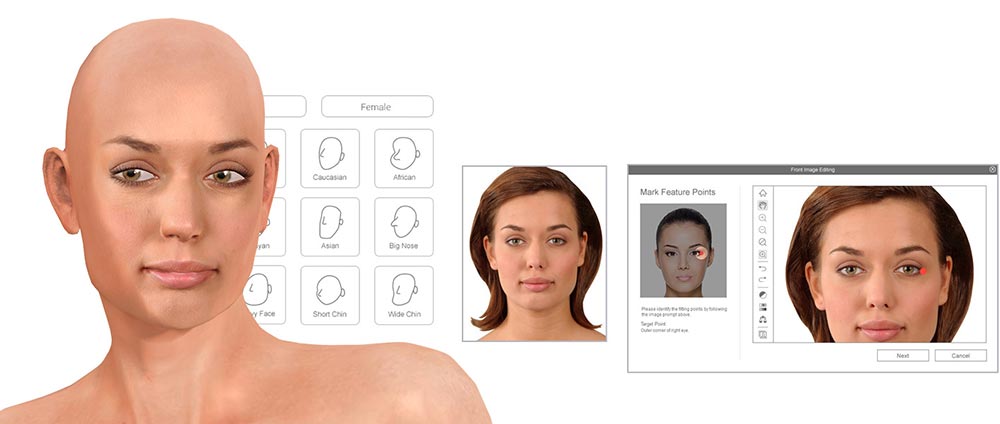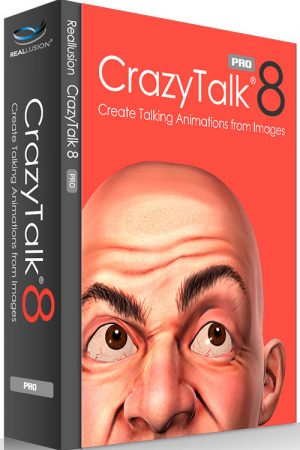 Publisher: Reallusion, Inc.
Publisher: Reallusion, Inc.
Website: http://www.reallusion.com/
Platform: PC/Mac
Description: Basic 2D/3D animation software
Purchase/Subscription: Purchase
Pricing: $49.99 Basic / $149.99 Pro / $199.99 Pipeline
Download Demo: Click Here
Discount: Click Here
Expected Release: Available Now
Review Issue: #137 (07/17)
Reviewed By: Jeremy T. Hanke
Final Score: 8 (out of 10)
When our affiliate, DarkestGoth Magazine, needed a cutting edge video talk show that pushed the boundaries of microbudget creation some years ago, we helped them look at the notion of making it an animated show. The concept of a real talk show that’s entirely animated hadn’t really been explored, so that’s the realm we pushed into for their flagship creation, Whiskey & Chai: The Silas & Ami Show .
Over the past four years, I’ve used CrazyTalk to help them create the show, starting with pre-composited backgrounds and human amalgamation avatars which then moved on to true green screen backgrounds (so that we could composite in Premiere Pro) and a more 2D cartoon style avatars.
In that time, I’ve become very familiar with what CrazyTalk 7 (CT7) is capable of and was very interested when it came time to review CrazyTalk 8 (CT8) to really put it through its paces, see where improvements were made, and what areas still need some improvement. I created the following 2D animation with my son to dial in the differences and similarities.
I’m largely going to emphasize the changes present in CT8 in this review, but you can read through my review for CT7 to get a better feel for the program.
Ease of Use
For an animation program, new users will still find that CrazyTalk’s learning curve is pretty mild, and the cleaner layout unveiled in CT8 makes it easier to follow the guides they’ve provided—especially in regards to creating not just 2D models, but actual 3D models. In comparison to other 3D programs, the actual 3D model creation is a lot closer to the simplicity of creating your own character in a video game like Skyrim.
One of the biggest improvements that Reallusion has put into this new software package isn’t in the software itself, but in the creation of a lot more video and tutorial assets for new users. That will make the learning curve much lower for everyone.
As with CT7, when it comes to 2D animation, you will still be far better to create a transparent background .PNG of your model in Photoshop or GIMP and then import that into CT8, rather than using CT8’s matte removal tool (which doesn’t seem to have been upgraded at all from what was in the last version).
Ironically, this recommendation isn’t the case for creating a true 3D character, as CT8 will be essentially skinning only part of your face, and then removing the rest of the image anyway. (Do make sure the images you use for front and side are the same proportions and relative size, or you’ll end up with weird results. This means you don’t want to try to do a front and side selfie; nor do you want to be wearing glasses.)

Creating a bearded avatar is tricky enough to require a separate tutorial at places like Renderosity. However, even for a new user, the 3D creation engine is pretty robust.
The default options that come with the 3D part of the program make it very easy to customize, as well, and past saved automotion presets can be used for both 2D and 3D models interchangeably.
Despite all these great things that make CT8 a no brainer for new and infrequent past users to upgrade to, there are some bad things that will make existing users really reluctant to upgrade. First, despite reading the automotion custom presets from CT7, CT8 won’t let you open any of your specific motion presets or custom animations from CT7, as the .ct7motion files from before aren’t compatible with CT8, which now uses new .ctimotion files. (This is doubly frustrating because not only is there no converter available for transforming .ct7motion to .ctimotion files, but the animation preset packages that people purchased for use with CT7 haven’t been ported over for CT8 nor does it look like they will be ported.)
These wouldn’t be impossible hurdles if you could just open projects from CT7 within CT8 and save your old motion presets as brand new .ctimotion files, but, unfortunately, that doesn’t work, either, as I discovered definitively both before AND after completely rebuilding my editing computer. Now, CT8 doesn’t tell you that you can’t use CT7 project files, as it will allow you to load them from your “open project” window, but it’ll stop functioning at the 60% load mark and just freeze your computer. (This is the software compatibility equivalent of taking someone on an expensive third date and then, right before you get back to their place, they pretend to get diphtheria; which is then followed by a week of your calls going straight to voicemail. Eventually, you do get the message, but you’re left feeling strangely emasculated and wondering why they couldn’t have just told you that you were out of luck directly.)
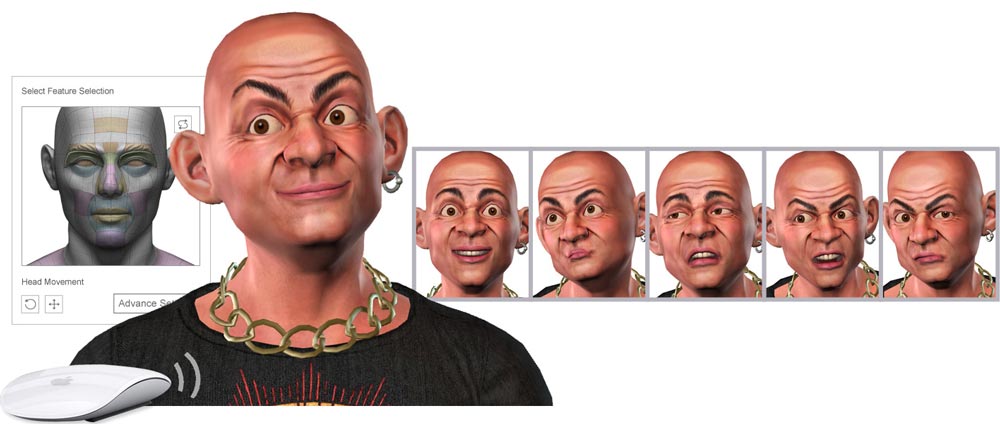
The options for puppeteering continue to be strong in CrazyTalk 8, which now debuts on Mac, as well as PC.
Depth of Options
The big news in CT8 is in regards to 3D, which we’ll cover more in just a second.
With that said, the actual options for the 2D component of CT8 haven’t changed a lot since CT7.
The biggest change they’ve made across the board is the inclusion of the option for 54,000 frame timelines rather than 27,000 frame timelines. For those not fluid in frame rates, this means that timelines can now be 30 minutes long, rather than 15 minutes long, which was a huge gripe I had with CT7. Despite the improved length, you do still need to input the length you want your timeline to be as frames, not minutes, even if you’ve chosen minutes as your time rate. (Ironically, this appears to be a late improvement, as the website still claims that 15 minutes is the maximum length for a project in CT8.)
Other than that, they’ve added a couple resolution additions, including mobile optimized sizes and UltraHD (in 4K and 3K flavors), and they’ve improved the dockable frames a bit (although they still don’t permit “reflowing” of the content in the panes, like Adobe products do).
One of the things that came to light after our last review was that CT7 doesn’t do alpha channel exports (ie transparent backgrounds), which resulted in us having to create green screen backgrounds for Whiskey & Chai. We had hoped this option might be included in the new version of CrazyTalk, especially since CrazyTalk Animator 3 provides a transparent background option, but, unfortunately, not. (Even 3D animation can’t be rendered out with a transparent background in CT8.)
You also are still limited to just a single character in an animation, so CrazyTalk continues to require an actual editing solution to create multiple character animations. (With creative greenscreen, you can get a lot of animated people in one shot, as the Whiskey & Chai episode shows: https://www.youtube.com/watch?v=1itLzD48QE8 )
As mentioned before, 3D is where the bulk of innovation for the Depth of Options was put and, honestly, for a lot of folks interested in doing talking-head style animation, this could be a game changer, because the 3D morphs look a lot more convincing than the pseudo-3D 2D morphs found in the main version. In my testing, I could see how this could be very helpful for someone wanting to rediscover a Max-Headroom-style mascot for a brand or to create a new smart aleck film critic (ala Jeremy Jahns from Collider, who, defying all rational explanation, is somehow not actually 3D animated).
The recommended way to create a 3D character is by using both a front image and a side profile for more accurate skinning is really cool and results in a much more believable composite in the end. (You won’t confuse this with the $10,000 full head scans they do on big budget Hollywood movies for their 3D models, but this is still pretty impressive.)
Once you’re done creating your character and dressing your character, you can choose not only regular backgrounds like you’re used to, but you can also choose pre-designed “Atmosphere” backgrounds that include corresponding animated lighting and even wind. (While no fog or dust is available, you can animate your light and wind, and these effect your model and any accessories or hair in a lot of cool ways.) Atmosphere’s are just one of the things you can do to your creations that are new to CrazyTalk.
Additionally, you can choose any number of different clothing items and/or accessories for your character to wear. (Because your character will usually have either a default male or female body with no real customization to those bodies, the clothes tend fit quite well, as a rule. You can get expansions with more heads and bodies, but fortunately the customization options will let you enlarge and reposition clothes and accessories as needed, which is nice.) Check out the following video of some different clothes on my avatar and some different environments he finds himself in.
While there are no options for directly importing new 3D objects from other 3D programs, there is a large library of converted objects, items, bodies, and clothes that are being created at the Reallusion Marketplace for you to import into CT8.
Performance
As with CT7, for projects 10 minutes or less, the overall performance for CrazyTalk8 was very good and it was fairly stable on my PC. Once we got into projects that were longer, especially those with a lot of sub-animation or with more auto-animation movement, we had more sluggishness creep in and had more stability issues (although CT8 does seem to be generally more stable as a whole than CT7). Rendering 3D and/or working with Ultra HD was correspondingly longer, but not especially tedious.
The similarity between CT7 and CT8 when it came to actual lag and delay was where I became extremely confused because one of the big performance improvements in CT8 is that it is now 64-bit, so it can address all the ram and resources that a modern computer has access to (unlike CT7 which is 32-bit and could address a fraction of the resources in most computers).
I know that the specs on my editing computer aren’t bleeding edge anymore, but when Adobe’s entire x64 pro-line runs smoothly even when compositing multiple layers of greenscreen in real time, yet I run into the exact same lags and slow downs when animating 2D timelines in CT8 that I did in CT7, it makes me wonder if this was simply a shell upgrade to x64, rather than a kernel upgrade. (Shell upgrading is repackaging a program so that it is registered as a faster program by the computer, even though it runs at the same speed as before, while a kernel upgrade is reworking the engine entirely so that a program functions faster.)
When it came to actually creating original 3D character faces, the software performed nicely. It was pretty easy to set everything up and then layout the points of reference markers to create the 3D model. Unfortunately, in most of my tests, I noticed that the lines (called “Splines”) which connected these points on the face would grow twisted no matter how carefully I placed the points as the 3D engine tried to unify both the front and side profiles. In true 3D space, these twisting Splines transformed planes of the 3D model and often resulted in strange deformities to the skull. (One that I created of myself left me with highly protruding forehead ridge that made me look like I was a Klingon from Star Trek: The Next Generation. Fortunately, I could hide my deformed head with a garish wig and make the model useable, but it was challenging.)
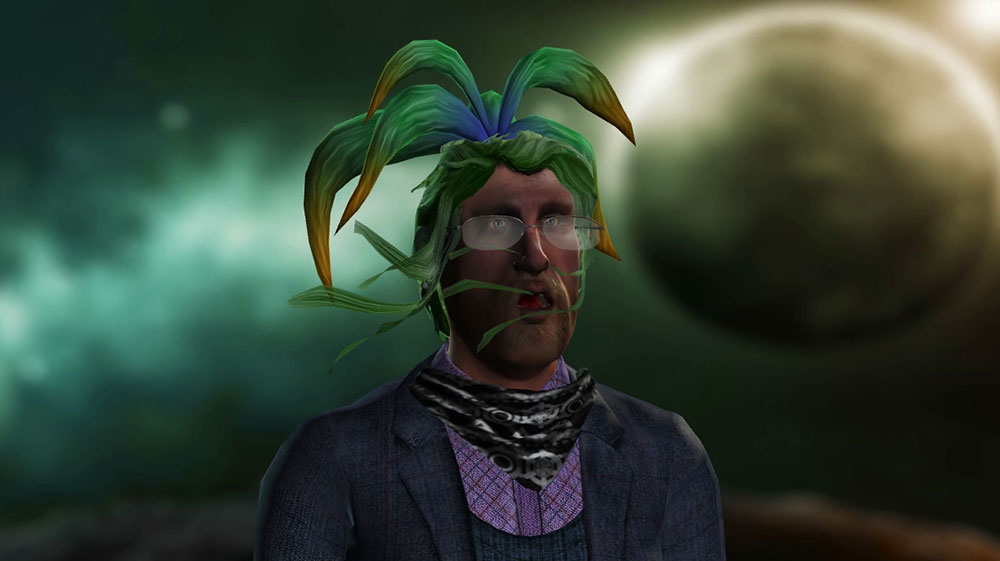
The garish wig helps hide a Klingon-style deformity in forehead. (These issues were less likely to occur when you did NOT use a side profile photo.)
The other issue with 3D was that this is where we saw the biggest performance lag, not when it came to rendering out the animated final version, but when it came to actually adding new motions to the 3D timeline in the first place, as there isn’t an option to switch out a lower-quality model (called a “proxy”) for the computer to animate, so, instead, the computer had to think about each animation added while trying to render out a final quality animation at the same time. (Now, they do try to help with 3D animation by letting you “record” 3D physics movements ahead of time so it’s not rendering it live, but some sort of proxy/temp skeleton is needed for animation in the future.)
Things I’d love to see in the future for CrazyTalk8 are:
1. True 64-bit processing, so that the software can take advantage of all of the RAM available.
2. Improvements on spline adjustments when creating 3D characters.
3. Improved performance on 3D projects, including proxies/temp models for animation tasks.
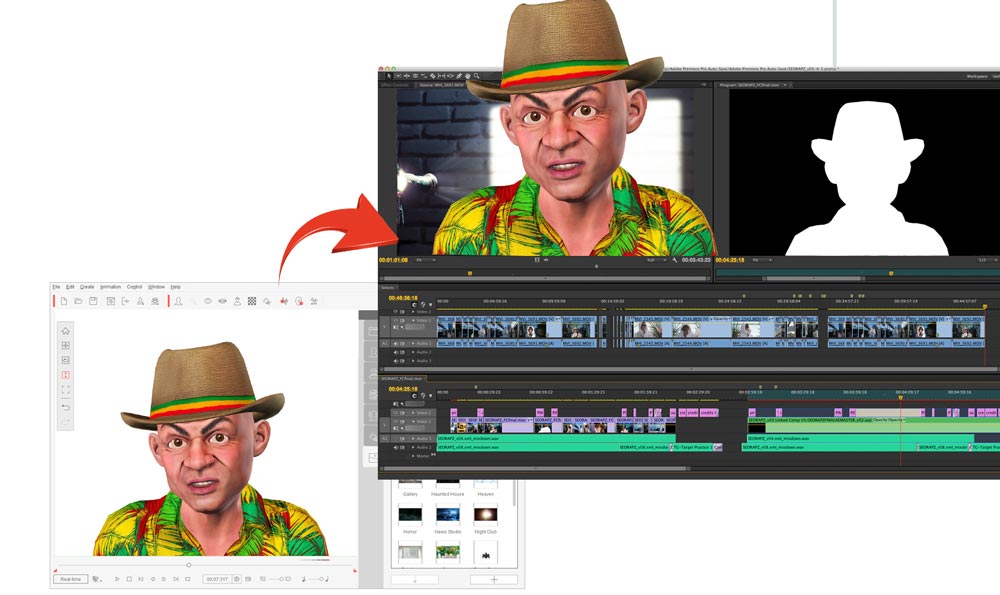
Although it won’t do true transparency (causing me to end up using green screen for most of my work with CT8), the folks at Renderosity do make a correct point that you can render out a white background and, in most cases, overlay it successfully in lieu of true keying.
Value
For most of our readers that are new users to this program, the $150 Pro version of this software is what you’ll want, since it includes not only a lot of models, backgrounds, and presets that the Basic program does not, but also the ability to actually make custom 3D characters and other important things for filmmakers.
You now also have a third tier option: the Pipeline addition, which costs an extra $50. The pipeline addition has the ability to create 3D .ctiHead files, which can be opened in the Reallusion’s Character Creation program or directly in iClone (Reallusion’s 3D program). Unfortunately, you can’t actually export the body, accessories, or backgrounds you used in CT8. As such, you’re essentially using the CT8 Pipeline to create the first step for a true 3D model which you’ll complete in the Character Creation program or for a new head mask which you’ll import for a pre-existing iClone model. How useful that is will depend on how you’re wanting to use this program, but it seems unfortunate that the option for exporting a full body and/or the ability to export to other 3D formats like FBX or BLEN was omitted with this release. Hopefully this will be addressed in the future.
The value for CT8 is largely based on what type of user you are. New users who want to be able to step into morphing 2D animation and basic 3D work will find the Pro version a great value and a great place to step in. Established users, on the other hand, get a lot more negatives if they’re already using CT7 regularly and will likely only upgrade if they’ll be using the 3D character elements a lot.
Final Comments
CrazyTalk continues to be an impressive animation option and CrazyTalk 8 opens some new doors for true 3D animation that have been lacking in past releases. For new and sporadic previous users, this is a great time to jump in. For regular CrazyTalk users who aren’t wanting to dabble into the 3D elements of CT8, it’s best to wait for CT9 and see if that version includes backwards compatibility (or at least conversion options) and improved workflow in the 3D world into the mix.
If you’re on the fence, download the free trial and see if CT8 works for what you need.
|
Breakdown
|
|
|
Ease of Use
|
7.5 |
|
Depth of Options
|
9.0 |
|
Performance
|
8.0 |
|
Value vs. Cost
|
7.5 |
|
Overall Score |
8.0 |

